| revcom.us
The Planet Cannot Survive Four More Years of Trump!
Part 2: The Arctic:
Land of (Melting) Ice and Fire
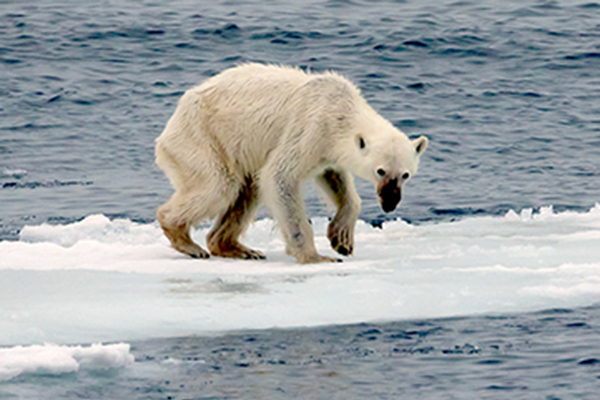
Starving polar bear (Photo: Wikimedia commons)
Editors’ Note: We received the following from a reader—the second in a series on the destruction of the planet’s ecosystems that has been brought to new levels of devastation and danger under the Trump/Pence regime.
Update, November 18—The Trump/Pence regime is breaking further norms and precedents in its rush to sell oil drilling rights in the Arctic National Wildlife Refuge (ANWR), in the final weeks before it is supposed to leave office. ANWR is one of the last extended areas of wilderness in the U.S. and home to many unique and threatened species. On November 17, the Trump administration announced “a call for nominations” for drilling in the pristine region. This gives companies 30 days to identify the land that they want to drill and for comments on the sale. Normally, such a period would be followed by several months during which the government would review the proposals and comments. But Trump’s Department of the Interior is expected to move immediately to give a 30-day announcement of the sale and hold the sale just a few days before they are scheduled to leave office. After the sale takes place, it will be much more difficult for a new government to reverse.
This article, written in August when the final environmental reports on drilling in ANWR were pushed through, outlines the environmental importance of the region, the grave threats posed by drilling, and the regime’s threat to the environment globally. The ramming through of the sale of these oil leases points to the danger this regime causes every day it remains in office. Trump/Pence Out Now!
***
Capitalism has ravaged and destroyed the planet’s environment since its beginnings, and, in recent decades, this has threatened the natural underpinnings of human society. Whole regions of the planet—ecosystems—are on the verge of collapse as a result of climate change driven by emissions of fossil fuels and other forms of ecological destruction.
Trump has thrown gasoline on an already raging fire and greatly accelerated this process, with perhaps devastating implications for the planet and humanity if he is reelected and consolidates his fascist regime.
This series looks at parts of the world that are under imminent threat. Part 1 looked at the Great Barrier Reef and the Amazon rainforest. Part 2 examines the Arctic.
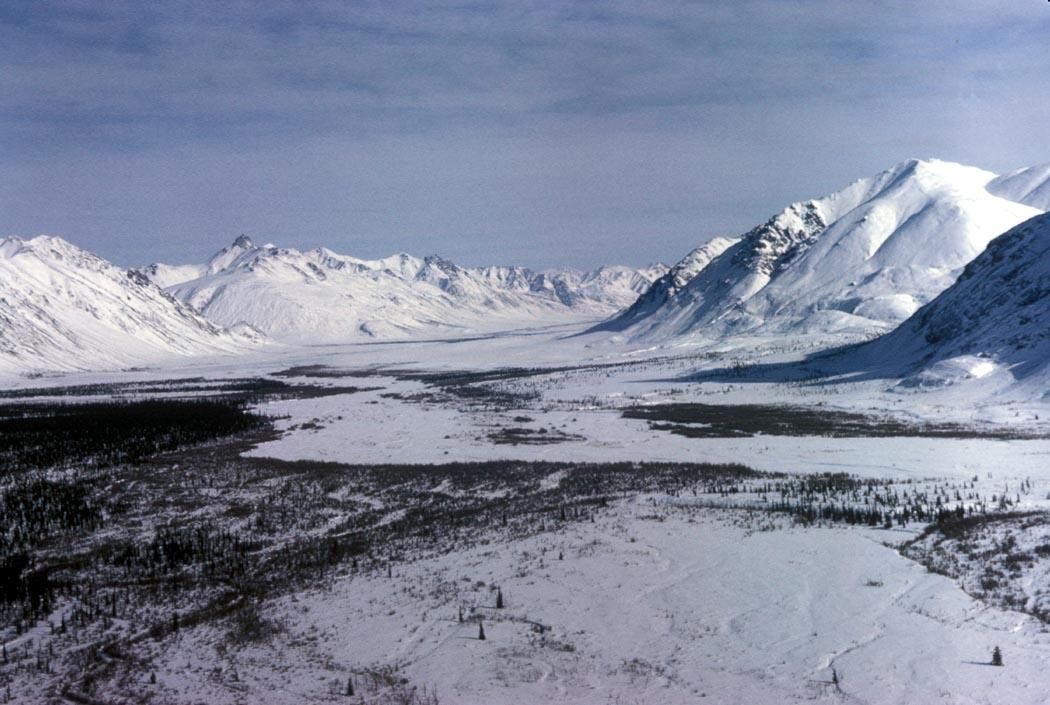
The Arctic in the winter. Photo: Wikimedia commons
The Arctic is like no other area on Earth. Its diverse landscapes range from sea ice to coastal wetlands, wide rivers, and the sea itself. The temperature plunges to an average of -40° F in winter.
Cold, month-long nights, frozen land and ice, would seem to make it an unwelcome place for life. Yet the Arctic is teeming with different organisms that have evolved adaptations to live in these extreme conditions. Some fish have evolved a protein to keep their blood from freezing. Seals, walruses, whales, and other animals have blubber to insulate them from the cold. Indigenous peoples have forged a way of life that can thrive and sustain in this harsh climate.
The planet is warming but the Arctic is heating up twice as fast as the global average. This year, a Siberian town reached 100° F, the highest temperature ever recorded in the Arctic. Projections indicate that if greenhouse gas emissions continue at the current rate, by 2050 temperatures in Greenland will be higher than they have been in 125,000 years.
The Greenland ice sheet is a body of ice 1,800 miles long and 1,100 miles wide. In recent years it has lost massive amounts of ice. Ian Howat, author of one study, suggests that the ice sheet has passed what scientists call a tipping point: “The ice sheet is now in this new dynamic state, where even if we went back to a climate that was more like what we had 20 or 30 years ago, we would still be pretty quickly losing mass.”
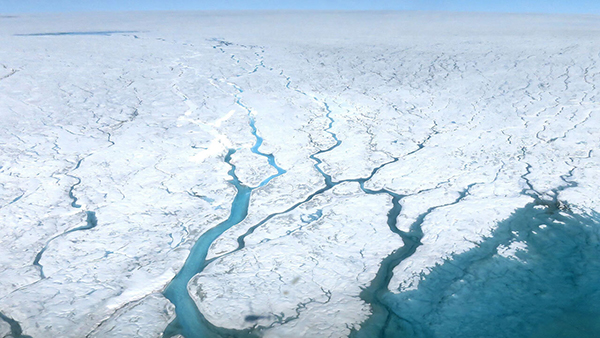
This aerial photograph shows fast-moving meltwater rivers flowing across the Greenland Ice Sheet, which has lost massive amounts of ice in recent years. (Photo: NASA)
The melting of the Greenland ice sheet would take place over many years, even past the current century. Passing a tipping point would mean that sea level rises of 24 feet, enough to put London, Manhattan, Miami, Mumbai, and many other coastal cities under water, forcing the migration of hundreds of millions, would be locked in place.
In addition to ice sheets, there is sea ice which floats on top of the ocean, and which once covered vast stretches of Arctic ocean year-round. Rising temperatures also increase seasonal sea ice melts. The amount of sea ice remaining at the end of summer has dropped 40 percent in the last three decades. If current trends continue, there will be no sea ice remaining in the summer by 2035.
Melting creates three issues for the Arctic region and for the planet’s climate. All three create dangerous feedback loops.
First, because sea ice reflects 90 percent of the light that falls on it while water reflects much less, the melting sea ice contributes to the warming of the planet—and that makes the ice melt that much faster. David Wallace-Wells writes in his book, The Uninhabitable Earth, that this dynamic alone could contribute as much carbon to the air as the last 25 years of greenhouse gas emissions.
Second, huge amounts of carbon and methane have been locked beneath Arctic permafrost for thousands of years. As the permafrost thaws, it releases these greenhouse gases. It is not known how rapidly this will take place. Several studies this year have predicted a much more rapid melting of permafrost than previously predicted. The National Oceanic and Atmospheric Administration writes that by 2100, the Arctic will have released greenhouse gases equivalent to half of the carbon emitted by humanity since industrialization began.
Third, for the last two years huge fires have burned across the Arctic. In just two Eastern provinces of Siberia, 34.6 million acres burned, 25 times the total area burned by all the fires in California this year. While fires have always taken place in the Arctic, the recent fires represent a transformational shift, burning longer and farther north.
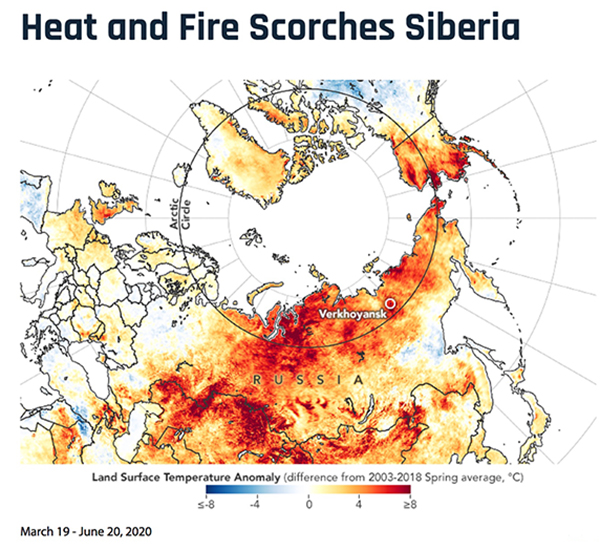 Credit: NASA
Credit: NASA
More than 50 percent of this year’s fires were on peatlands, carbon-rich soils that accumulate from organic matter over thousands of years. Warmer weather melts the ice that covered it year-round, and longer summers dry it out. A new phenomenon called “zombie fires” is emerging. Fires lay smoldering beneath the ice and snow all winter and then emerge, zombie-like, in the spring. They can burn for years.
The Arctic fires are putting huge amounts of climate-warming gases into the atmosphere. In June of 2020, Arctic fires released more carbon into the atmosphere than the country of Norway did in an entire year.
The Arctic, like all ecosystems, is a complex web with every species, including people, interacting with other species and the physical environment. It is not clear where all this will lead. What is clear is that many species are vulnerable and that little is being done to protect them. (See sidebar: Threatened Species in the Arctic.)
The Arctic evolved over millions of years. Now, as a result of a few decades of human activity, it is threatened with collapse; many species may be lost forever. One of the last areas relatively untouched by human activity spoiled, landscapes of pristine beauty never seen again.
What happens in the Arctic will reverberate in other ecosystems and disrupt human activity. Rising seas can drown whole cities and cover islands, giving rise to perhaps hundreds of millions of climate refugees. Sixty percent of fish sold in the U.S. are from the Arctic. Changing ocean currents will have unpredictable consequences. Our children will face a very different world. For our grandchildren there is a question of survival.
“Not fit caretakers of the earth” — clip from Revolution: Why It's Necessary, Why It's Possible, What It's All About, a film of a talk by Bob Avakian given in 2003.
Threatened Species in the Arctic
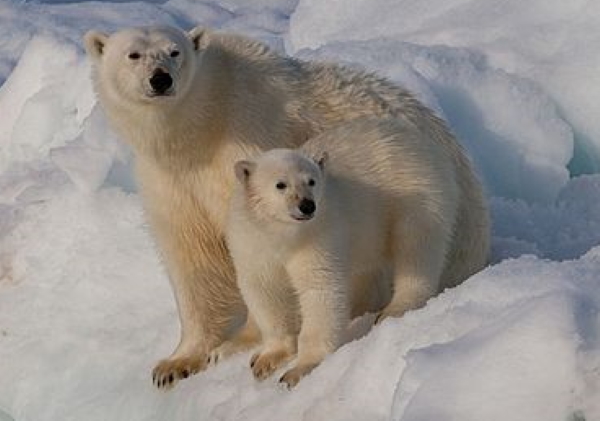
Polar bear and cub, Norway, 2015. Photo: AWeith, Wikimedia Commons.
Polar bears: As sea ice melts the bears have less area to hunt seals, without which they can starve to death. Those that do survive give birth to smaller offspring. At a certain point—perhaps in the near future—most of the offspring won’t survive.
Walrus: These huge mammals hunt for food on the sea floor. In between hunts, they rest on sea ice. As sea ice disappears, the walrus have few places to rest. Two-thirds of Pacific Walrus go to a single beach. Some have been filmed climbing up cliffs and falling to their deaths (see video).
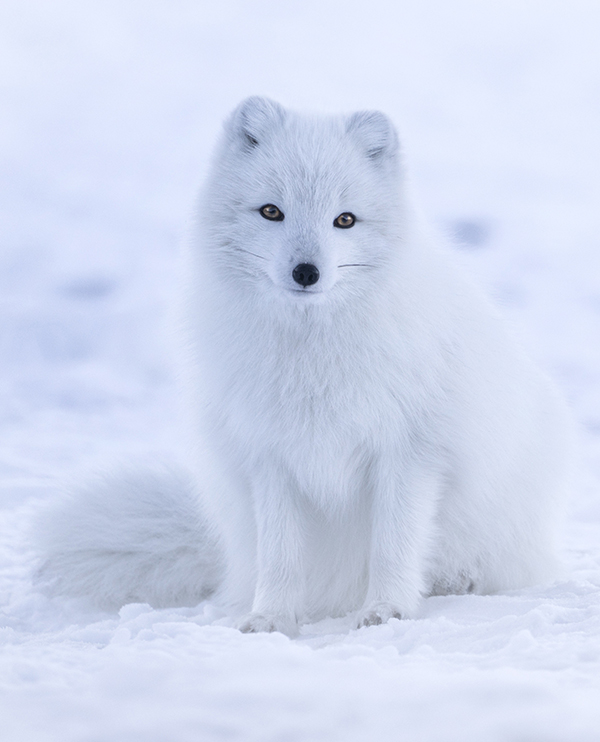 Arctic fox. Photo: Wikimedia commons
Arctic fox. Photo: Wikimedia commons
Arctic Fox: Its coat changes from white in the winter to brown in the summer for camouflage. It faces new competition from the red fox that has migrated north due to warmer weather and because its main food source, lemmings, are threatened by loss of snow to burrow into.
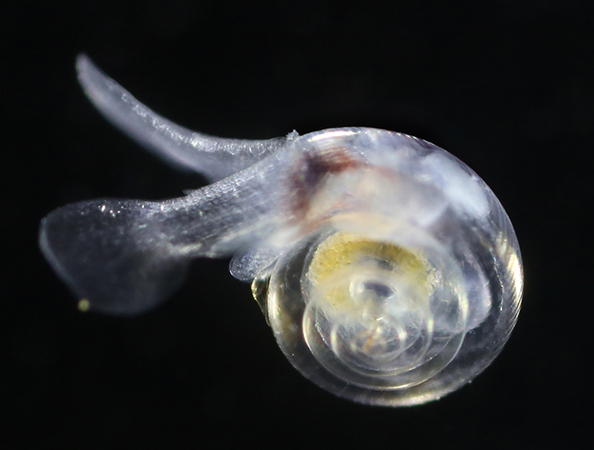 The Sea Butterfly, a tiny ocean snail with wing-like structures, is a key food source for much marine life. It is threatened by ocean acidification linked to climate change and could disappear in the next few decades. (Photo: NOAA)
The Sea Butterfly, a tiny ocean snail with wing-like structures, is a key food source for much marine life. It is threatened by ocean acidification linked to climate change and could disappear in the next few decades. (Photo: NOAA)
Sea Butterfly: This elegant-looking tiny marine snail has developed wing-like structures to propel itself. It is also called the potato chip of the sea because of its importance as a food source for a range of species. Its primary threat is ocean acidification, caused by global warming, that prevents its shell from forming. These organisms will become extinct in the next few decades if current emission trends continue. The decline of the Sea Butterfly will have a dramatic effect in the Arctic seas and beyond.
Trump and the Arctic
The majority of the environmental devastation in the Arctic is the direct result of climate change caused by the burning of fossil fuels. This did not begin with Trump; it is the result of a system of capitalism-imperialism, its cutthroat competition, and its quest for profit. But Trump is greatly accelerating the process.
Trump has denied the science of climate change, pulled out of the Paris climate accord, promoted and deregulated coal power plants, repealed rules that would have reduced automobile emissions, cut regulations on methane, approved contested pipelines, and expanded drilling coal mining and fracking.
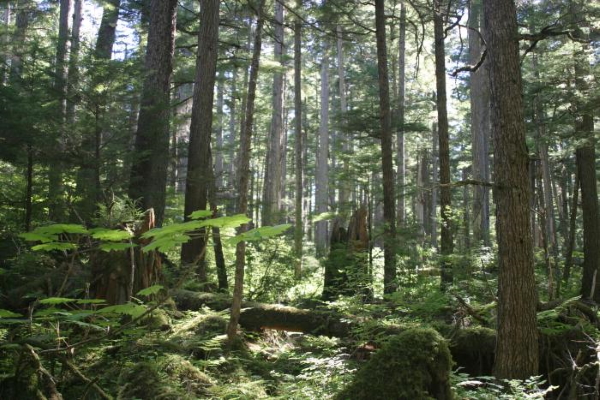
Tongass National Forest, 2004, Alaska. Wikimedia Commons.
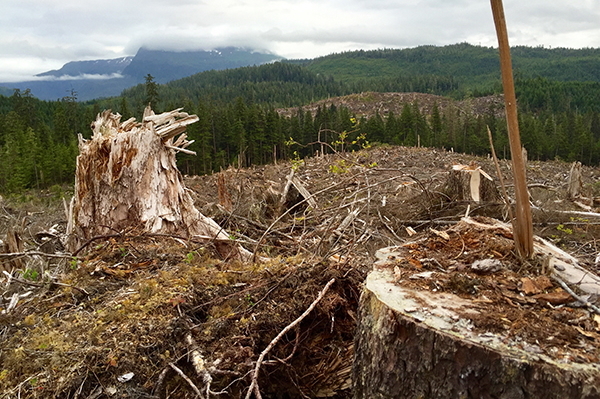
A recent photo of the Tongass National Forest. The destruction has begun.
In addition:
- Trump has initiated at least six projects on federal lands in Alaska that would further destabilize the region’s environment. For example, Trump is on the verge of selling oil leases in the Arctic National Wildlife Refuge that would endanger species such as polar bears and the Porcupine caribou, and disrupt the lives of the Gwich’in people. In 2019, Trump applied to change rules that prevented building roads and logging in the Tongass National Forest. This would remove protections for 165,000 old-growth and 20,000 young-growth acres and is being opposed by the Tlingit, Haida, and Tsimshian people.
- The Trump administration has weakened the Endangered Species Act that has been in place since 1973. For example, they are working to eliminate what is called the “blanket rule,” which mandates that species be protected that are threatened but not yet declared “endangered.”
Four more years of Trump’s science-denying, nature-destroying, fossil-fuel-emitting fascist regime will be a nightmare for the planet. We must use all available nonviolent means to prevent Trump/Pence from consolidating fascism. AND, to save the planet, we need to overthrow the capitalist-imperialist system and put in place a system of socialism moving on to communism that is based on, among other things, “Protecting, preserving, and enhancing the ecosystems and biodiversity of the planet for current and future generations.” (From the Constitution for the New Socialist Republic in North America, authored by Bob Avakian.)
“Cold War” in the Arctic
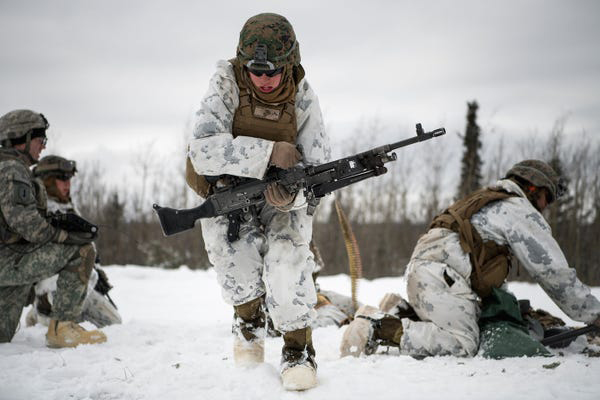
U.S. Marines participating in Arctic Edge 2020, the largest joint military exercise in Alaska this year. (Photo: U.S. Marine Corps)
As the sea ice melts, the United States and other capitalist-imperialist powers are focused not on protecting the ecosystem but on extracting strategic resources (mainly oil), defending strategic sea routes, and developing a military presence to protect their interests.
In 2019, U.S. Secretary of State Mike Pompeo said it was “America’s moment to stand up as an Arctic nation.” Pompeo does not give a damn about protecting the environment. That same year, he WELCOMED the melting of sea ice because it opens opportunities for trade. What worries Pompeo is that Russia is pushing its interests in the Arctic, including developing a route that Putin hopes can replace the Suez Canal, building massive oil wells, and increasing Russia’s military presence.
After Pompeo’s declaration, the U.S. deployed destroyers off Russia’s northern coast and announced that it would deploy 100 F-22 and F-35 fifth-generation fighter jets to Alaska, where U.S. aircraft intercepted Russian warplanes at least a dozen times this year. U.S. and Russian submarines are under the ice in numbers not seen since the Cold War.
Bob Avakian summed this up perfectly in a talk: “This system and those who rule over it ... care nothing for the rich diversity of the earth and its species, for the treasures this contains, except when and where they can turn this into profit for themselves... These people are not fit to be the caretakers of the earth.”
Next Week—Part 3: Oceans
Get a free email subscription to revcom.us:

